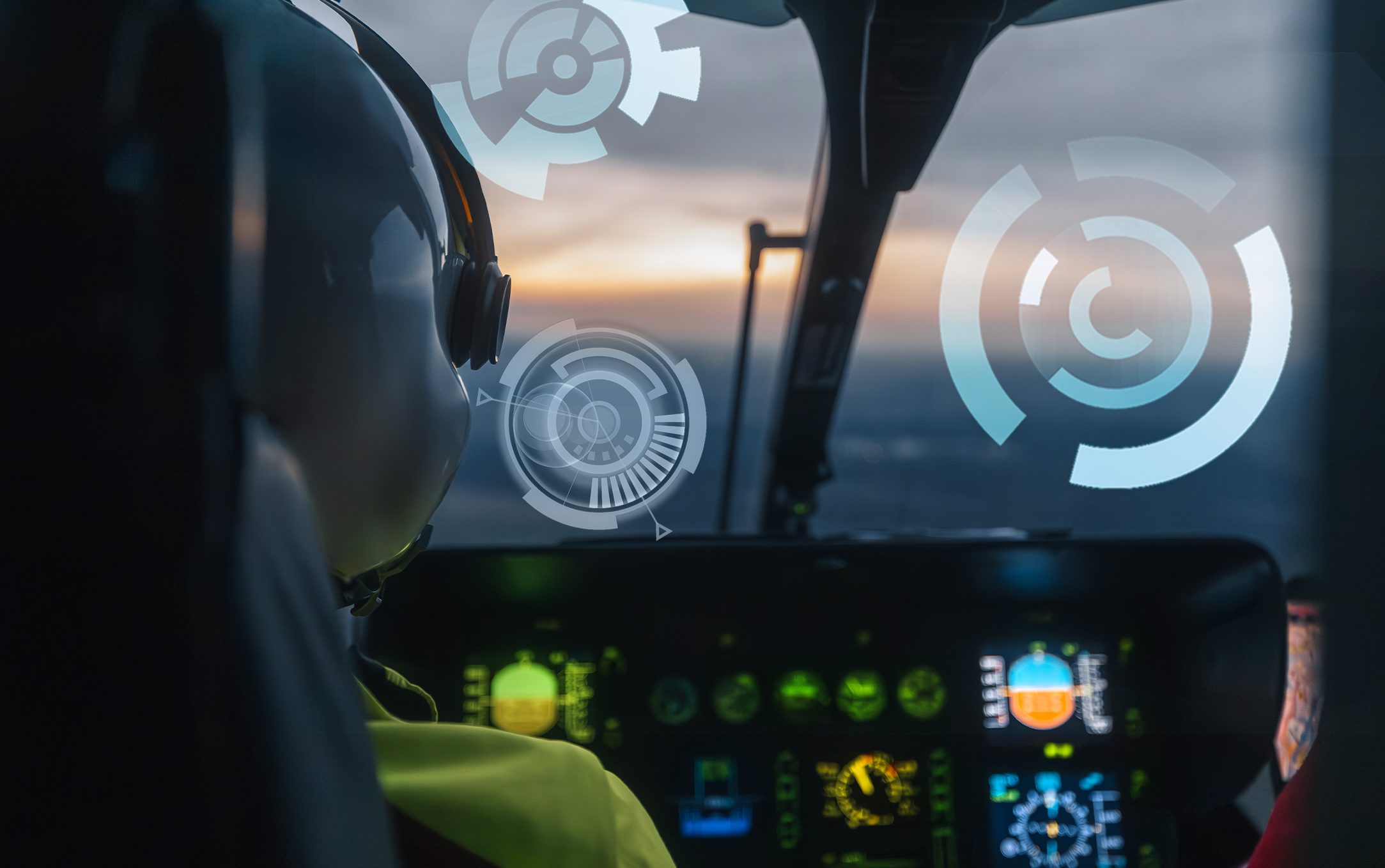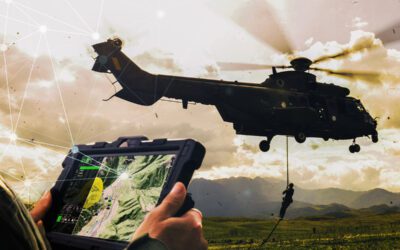The artificial intelligence (or AI), this revolutionary technology is finding its way into every aspect of our lives and is proving (on the whole) to be beneficial. The aviation industry is undergoing seismic changes and much of that is a result of AI.
Artificial intelligence in aviation could revolutionise how commercial, military and private operators think about flying, from mission management to real-time data gathering and pilot support.
In this article, we will take a more in-depth look at the use of AI in aviation and how it has become a significant force in all industries. We will consider the pros and cons of AI and examine the role of human operators alongside AI. We will also investigate real-world applications, assess their impact, and how the technology should move forward to the next generation of AI.
How much is AI in aviation worth?
The numbers demonstrate just how pivotal aircraft artificial intelligence really is. According to research carried out by Straits Research, AI in aviation is taking a larger share of the industry’s value year on year. The aviation AI market was valued at US$728.05 million globally in 2022. By 2031, it is estimated that number will climb to US$23 billion. This is potentially one of the biggest markets for AI on the planet.
The rise of AI in all industries
What started as a series of YouTube videos from Boston Dynamics showing how AI and robotics work in synergy has snowballed into a worldwide and globally impactful industry. AI is here to stay, from digital art manipulation and content generation to home appliances, automobiles, and factory floors. It’s in our workplaces, our homes, and even our fridges.
However, just like the rise of computers, the early versions of AI leave much to be desired. And fundamentally, human input is still an essential part of their operation. AI is not autonomous. We still have to be there.
But AI is getting better every day. Thanks to machine learning, this technology can evolve and grow, adapting to every individual scenario and calculating the most effective solution in nanoseconds. This ability to learn and develop is what makes artificial intelligence in the aviation industry so important and useful.
The main applications of AI in the aviation industry
AI in aviation has countless uses, both on the ground and in the air. From creating fast, responsive customer care provision and online booking to deep-diving into more technical data such as fuel consumption and aircraft maintenance schedules, AI has a role to play.
While it may be interlinked with other elements, such as safety and security, human intervention will always be required. So, AI is not going to replace a highly skilled human safety technician or an aircraft engineer anytime soon.
Boeing has been one of the forerunners in incorporating aviation artificial intelligence into their forward planning. For them, AI’s key role is in data analysis in six areas:
- Knowledge extraction – using AI to search through documentation to pull out key elements
- Anomaly detection – spotting anomalies and locating unseen issues long before they can compromise the operational safety and efficiency of an aircraft
- Decision-making – providing data to aid key decisions and mission-critical commands
- Conversational assistance – designing and operating language interaction systems such as customer query lines so that the user feels they are talking to a real person
- Computer vision – assessing and transforming images and video into tools that can be used for deep learning
- Autonomous flight – providing the next generation of aircraft with new capabilities, including the potential for truly autonomous flight.
All of these technical applications of AI in aviation can be applied to other aspects of the aviation industry. Much of the original technology has come from military development, and AI continues to play a hugely important role in that theatre.
However, the same elements, and in particular the ability to deep-dive into data analysis and knowledge extraction and provide operators with real-time augmented data, are the most important for the aviation industry as a whole.
Making aviation greener
There is no question that aviation has a huge carbon footprint. Aircraft burn massive amounts of fossil fuel, contributing around 2% of energy-related CO2 emissions globally. With a commitment to net zero by 2050 in most countries, the aviation industry is lagging in cleaning up its eco credentials.
Aviation AI has a role to play here, primarily by looking at the data and understanding the complexities behind the issue. As it assesses the challenge of creating a more sustainable and greener industry, AI can look at individual problems, extrapolate the data, and lay the path towards solutions that could significantly impact aviation’s sustainability and overall efficiency. This would cut not only carbon emissions but also costs and speed up development and innovation towards greener and more sustainable aviation technology.
Safety and maintenance
Robotics are increasingly used in the construction and maintenance of aircraft (once again, always with a human present!). But it has the potential to take a much more focused role in the future.
The FAA reported that unplanned maintenance accounted for over 7% of commercial flight delays in 2023. Using AI to analyse the data, airlines and operators can identify possible safety concerns from the data gathered and assessed from flight data recorders and sensors.
By doing this, an operator or even a manufacturer can identify and rectify potential issues that could potentially ground an entire fleet of aircraft or even cost lives if unchecked. The net result of this ability to look at Big Data in minute detail and extract the key elements from the background ‘noise’ is AI’s biggest advantage when it comes to safety.
Maintenance scheduling and servicing can be managed far more efficiently by AI. However, AI in aviation will always be backed up by human intervention, especially regarding safety and maintenance.
Training and simulation
Training a pilot takes time and money. Retraining is a continuous process as new technology comes online, and operators have to shift their roles both on the ground and in the aircraft itself. Once again, aviation AI has a vital role to play.
Using AI, pilot training becomes far more efficient as AI can analyse exactly how a pilot reacts to simulation training, including logging and examining both their mistakes and their efficiencies. The instructor and trainee can look at the results in great detail after a session in the simulator (also developed by AI). This allows trainers to customise their training programs to suit the individual. The result is shorter but more efficient training periods and lower costs.
This also applies to adding new technology. Helicopter AI has been particularly effective in reconnaissance, military applications and SAR. By incorporating augmented reality protocols into the operating system, crews can be more effective in target location.
As the AI and AR used is a system of ‘plug and play’ information layers using hardware that operators are already familiar with, the training time is once again reduced while efficiency increases.
For aircraft that are expensive to run, such as helicopters, every second is crucial and costly. Any system that makes the time spent in the air more effective is to be welcomed.
The future of AI in aviation – How will the technology evolve?
Ten years ago, nobody could have guessed that AI would play such a pivotal role in so many elements of our everyday lives. Today, we recognise that, in theory, the possibilities are infinite. In the aircraft industry, AI is already being used by major carriers, the police, Search and rescue operators, and the military to improve efficiency, run select elements of the aircraft, and enhance safety.
On the ground, aviation AI is being used in every aspect, from airport management to weather analysis, customer services and ticket booking. There is literally no part of the process that is not influenced or aided by AI in some way.
In the future, this intertwining of AI will become more pronounced as it becomes more efficient and reliable, and thanks to machine learning, it will become more adaptable.
FlySight is at the forefront of this innovative technology, creating groundbreaking platforms such as OPENSIGHT. The seamless integration of both AI and Augmented Reality into operating systems for ground-based and mobile platforms creates a synergistic bond between the two. The technology uses familiar hardware so that operators require less initial training and can instinctively interact with the system.
🔎You can find out more about OPENSIGHT by watching our informative videos here. Delivering both turnkey solutions and development tools, OPENSIGHT offers a new way of introducing aviation AI into your system. Get in touch to learn more about FlySight’s aviation systems and solutions today.




